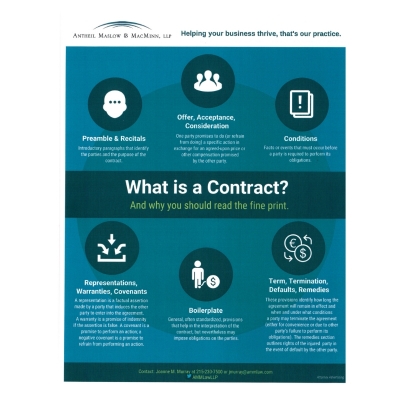AMM Blog
Welcome to the AMM Law Blog, a tool to help you keep up to date on current legal developments over the broad spectrum of our practice areas. We welcome your comments and suggestions to create a dynamic forum that will be of interest to readers and participants.
From a Litigator's Desk: Sometimes You Have To Just Blow It Up
Written by Thomas P. Donnelly Wednesday, November 14 2018 18:14Many of our previous posts delve into the benefits of resolution of a commercial or shareholder dispute without litigation. Cost, uncertainty and business distraction are factors which often weigh in favor of settlement even at a price which seems unfair. But making a deal necessitates a desire to do so from both sides. As they say, it takes two to tango. If one party is simply not so inclined or the final best offer is simply unacceptable, litigation may be inevitable, and the only mechanism available to bring about resolution.
In a corporate setting, that litigation may take several forms. Choosing the right path is fact intensive and dependent on the relative positions of the parties. Of course, the terms of agreement between business owners may either provide mechanisms for resolution or limit potential alternatives. Regardless, every course of action comes with significant consequences which must be carefully considered prior to embarking on what can be both emotionally taxing and expensive.
Minority Shareholder Strategies
A minority shareholder who is not actively involved in the business has limited options. Unless a shareholders’ agreement provide a mechanism for redemption or transfer, it may be difficult for a minority shareholder to compel a purchase. That minority shareholder would be left to argue that he or she has been “frozen out” from the business, i.e. excluded from information relating to management, oppressed or treated inequitably in terms of distributions of profits so as to trigger an obligation that the company redeem their shares at “fair value”. An action for the appointment of a custodian or receiver is the minority shareholders weapon of choice in that instance. Majority and controlling shareholders are loathe to lose control of what is often their economic life blood.
Majority Shareholder Strategies
A majority shareholder desirous of consolidation of ownership faced with a minority owner not interested in selling also has limited options to compel a sale. In the absence of an agreement which provides for same, there is no provision at law relating to corporations to simply expel a shareholder. With regard to llc’s, the Pennsylvania Limited Liability Company Act provides a limited number of circumstances where the right of expulsion may apply. In either case, involuntary expulsion of a minority interest is no easy task.
The Nuclear Option
The above being said, the nuclear option available to a controlling interest is dissolution. Blow it up, resign all positions which impose fiduciary obligations at law, liquidate the assets and start something new. While the process may be incredibly disruptive to the continuity of business and the personal finances of all the parties, if the separation of the minority interest holder is imperative dissolution may be the only option. The minority may scream breach of fiduciary duty, but in the absence of an agreement among shareholders that the shareholders would not move to dissolve, the success of such a claim at law is speculative at best.
In the end, the decision of whether to engage in such explosive tactics involves a financial analysis but also other factors such as whether the long term interests of the parties require same. In some cases, such as in professional settings, potential irreparable damage to reputation may demand action regardless of the short term pain such action may cause.
The Eight Corners Rule and the Liability Insurer’s Duty to Defend
Written by Gabriel Montemuro Thursday, November 08 2018 17:14Regardless of whether you are a liability insurance provider or the person being covered by a liability policy, a threshold issue to nearly every coverage dispute is whether or not the insurance provider is obligated to defend its insured in court. If an insurer is not obligated to defend its insured, the insured party is left to his or her own devices to secure and pay for legal counsel.
If an insurer is obligated to defend, but breaches its duty to do so, then it leaves itself exposed to potential liability since it did not perform its obligations under the insurance policy. Both sides of the conflict benefit from understanding the circumstances under which an insurer must defend its insured at the onset of a lawsuit.
Pennsylvania, like many states, has adopted the general rule that a liability insurer’s duty to defend is determined by comparing the allegations of the complaint to the terms and exclusions of the policy. This approach is informally known as the “Eight Corners Rule” due to the law’s emphasis on limiting the analysis to those two documents (each document has four corners – get it?).
The Eight Corners Rule requires that an insurer treat all allegations of a complaint as true, even if there is reason to believe the allegations could be groundless or false. If the allegations set forth at least one injury that is or could potentially be covered by the policy, then the insurer has an obligation to defend its insured against the lawsuit.
There are circumstances where an insurance provider can be relieved of its duty to defend. Usually, this occurs where the insurance provider reserves its rights to disclaim coverage and later discovers facts that would operate to exclude coverage. For example, an insurer may accept defense of a waste management company when it is sued and the plaintiff’s complaint alleges that he or she was injured when she tripped on a dumpster that was negligently placed in a dangerous location by the company. But what if, during litigation, it is revealed that the plaintiff actually tripped while avoiding a dumpster as it was being unloaded by the company’s trash truck? Most commercial liability policies exclude coverage from any damages arising from the use of the insured’s vehicle, including any loading or unloading of that vehicle. In that scenario, the insurance company may be legally entitled to withdraw its defense, leaving the insured party to hire, and pay for, its own defense and ultimate liability.
While an insurer’s obligations to its insureds can evolve throughout a lawsuit, understanding the Eight Corners Rule can be used by insurance companies and policyholders at the start of litigation to determine whether any genuine dispute relating to the insurer’s duty to defend exists, allowing the parties to more efficiently navigate the initial stages of a lawsuit
NAVIGATING NONCOMPETES PART 1: THE BASICS
Written by Patricia Collins Wednesday, October 31 2018 19:56A recent Washington Post article proclaimed that “even janitors have noncompetes now.” New Jersey and Pennsylvania are considering legislation to regulate the terms and enforceability of documents that restrict employees’ ability to compete with their former employees. "Noncompete Litigation Lessons from the 10th Circuit". These restrictions require discussion and attention: they impact the economy, employee mobility, and the trade secrets and good will of businesses. In the coming weeks, we will explore issues relating to noncompetes in order to shed some light on this complex employment law topic, and offer guidance to both employers and employees grappling with the potential risks and consequences of missteps in these agreements.
This week, let’s start with the basics.
Pennsylvania law recognizes that an agreement that restricts the ability to compete is a restraint on trade, and courts should construe them narrowly. Such agreements are only permitted in two contexts: where they are ancillary to the employer – employee relationship (including independent contractor relationships), or where they are ancillary to the sale of a business. The restriction must be reasonable in terms of scope, geography and time. A court will review whether the restriction in the agreement is narrowly tailored to address certain legally protectable interest, such as good will, trade secrets or specialized training.
Such agreements, as with all contracts, must be accompanied by consideration. In the context of employment-related noncompetes, continued employment will not suffice. Instead, the noncompete must be executed at the beginning of the employment relationship, or, if signed during the employment relationship, accompanied by additional consideration such as a promotion, raise or bonus.
Noncompetes come in many forms: restrictions on working for competitors or setting up a competing business; restrictions on soliciting or accepting work from customers, clients, vendors or suppliers; restrictions on working as an employee for a customer, client, vendor or supplier; and restrictions on soliciting employees away from the employer. Limitations on solicitation are generally more enforceable than blanket restrictions on competition. Some noncompetes are accompanied by a period of severance pay, commonly referred to as “garden leave”. Some agreements include provisions for the employer to release an employee from a noncompete under certain conditions.
When an employee breaches a noncompete, the employer has a powerful weapon to enforce the document: the employer can request an emergency order from the court prohibiting the employee, and even the employee’s new employer, from engaging in activity in breach of the agreement. The court proceeding that results in the emergency order, called a preliminary injunction, usually occurs quickly, and such litigation is expensive and stressful. Often, noncompete agreements have provisions that require the employee to pay the employer’s legal fees in the event of a breach. A court is free to “blue pencil” the noncompete. This means that the court can rewrite the restrictions in a manner that is reasonable and consistent with the employer’s legally recognized protectable interests.
In the next installment of my Navigating Noncompetes series, you will see how to apply some of these basics to examine the issues that employers should consider in drafting and enforcing noncompetes.
A corporation or limited liability company provides multiple advantages to business owners which is why business lawyers so frequently recommend their use. Among the most significant of these advantages is limited liability, a concept grounded in the fact that the entity has a separate legal existence from its owners and therefore its obligations are not those of its shareholders or members. Of course an owner may voluntarily agree to be responsible for such obligations as, for example, would be the case if he or she guarantees the entity’s bank borrowing. The shield of limited liability is not, however absolute. It can be breached rendering owners financially responsible for the entity’s obligations. In Pennsylvania, as in most states, there is a strong presumption against ignoring the distinction between the entity and its owners. However certain conduct by business owners will result in the court’s “piercing the veil” – ignoring the distinction between the corporation or limited liability company and its owners. Generally, courts will pierce the veil when those in control of the entity use that control, or use the entity’s assets, to further his, her or their own personal interests. While there is no single test to determine when the piercing of the veil is appropriate courts look to many factors.
These include:
1. Is the entity undercapitalized?
2. Did the owners fail to adhere to requisite formalities such as holding shareholder and directors meetings and keeping appropriate records?
3. Was the entity insolvent at the relevant time?
4. In the case of a corporation were dividends paid or were corporate funds siphoned into the pockets of the controlling shareholders?
5. Was there a functional board of directors and corporate officers managing the affairs of the entity?
6. Was there substantial intermingling of the financial affairs of the entity and its owner(s)? 7. Under the circumstances, was the entity form used to perpetrate a fraud? Generally, the court will pierce the corporate veil when a review of these factors shows that the form is a sham, constituting a facade for the operations of the dominant shareholder or member making the entity effectively the “alter ego” of the individual(s).
What is a contract: Part 2: Offer, Acceptance, Consideration: What’s in it for you?
Written by Joanne Murray Monday, October 29 2018 16:54This post continues my series explaining the main elements of a contract, which are outlined on the attached infographic. My goal is to demystify some of these basic provisions to help business owners have a better general understanding of what they are signing.
Moving through the structure of a typical contract, next up is offer, acceptance, and consideration. Together, these clauses define what the offering party is promising to do (or refrain from doing) in exchange for the compensation the other party is willing to pay or provide. They basically comprise the tit for tat, or the meat of the obligations and privileges which are being offered. This is often referred to as a “meeting of the minds.” While this might seem obvious on its face, the devil may be in these details, so it is vital that you know and understand the specific nature of your obligations and be sure that they are sustainable, practical, and likely to result in a benefit to your bottom line or some other benefit to your business. So what can happen when parties fail to clearly memorialize their “meeting of the minds”? Here are a few scenarios that could result:
• The parties might become embroiled in a “battle of the forms”, particularly in the sale of goods context where a buyer submits a purchase order using their company’s form, and the seller responds using their own terms and conditions form containing different and/or additional terms.
• Parties can ask the court to apply certain legal theories to supplement the “four corners of the document” where the intent of the parties may not be clear from the contract itself. For example, even if there is no formal consideration, courts can apply the theory of promissory estoppel to enforce a party’s promise to do something if the other party relied on that promise to his or her detriment.
• Another equitable remedy allows the court to compel a party to make restitution if that party is enriched at the expense of the other party and the surrounding circumstances lead the court to conclude that it is unjust.
• Pennsylvania has a little-known statute called the Uniform Written Obligations Act, which allows the court to infer that consideration exists where the agreement includes language that clearly and expressly states that the parties intended to be legally bound by the agreement.
Stay tuned for Part 3 of this series, which will move to the next element on the infographic: Conditions.
Visit ammlaw.com to learn more about our contract review services, or Joanne Murray.
NONCOMPETE LITIGATION LESSONS FROM THE TENTH CIRCUIT
Written by Patricia Collins Thursday, October 25 2018 19:07
Reprinted with permission from the August 18th, 2018 issue of The Legal Intelligencer. (c) 2018 ALM Media Properties. Further duplication without permission is prohibited.
A recent case from the United States District Court for the Tenth Circuit, First American Title Insurance Company, et al. v. Northwest Title Insurance Agency, et al., no. 17-4086, illustrates nicely the complicated issues faced in noncompete litigation, and the risks a good agreement can prevent. Although the case arose in the United States District Court for the District of Utah, the issues confronted and legal principles cited arise frequently under Pennsylvania law.
The individual defendants were employed by First American Title Insurance Company, and had signed various restrictive covenants of one year in duration. All individual defendants were subject to a code of ethics and employee handbook that required employees to use office equipment for company business only, and barred outside activity competing with First American. First American Title Company acquired the stock of First American Title Insurance Company pursuant to a Stock Purchase Agreement. Defendant Smith created defendant Northwest Title Insurance Company, and then quit his job with First American. The day after Smith resigned defendants Carrell and Williams resigned and all individual defendants took positions at Northwest Title Insurance Company, along with twenty-five other employees over the next two weeks. Litigation ensued, and defendants suffered a large jury award at trial.
Lesson 1: File petitions for preliminary injunction early, and make sure to have a tolling provision in the agreement.
The First American District Court denied the plaintiff’s motion for a preliminary injunction after a hearing, finding that there was no irreparable harm. Notably, the individual defendants resigned in March of 2015, and their restrictive covenants, which did not contain tolling provisions, terminated in March of 2016. Plaintiffs filed the petition for preliminary injunction in January of 2016, with only two months remaining on the restrictive covenants, and the motion was not heard until September 2016. The case then proceeded to a trial, resulting in the appeal addressed by the Tenth Circuit. An injunctive order entered early in a case tends to change the dynamic of a case going forward, providing opportunities for sanctions and contempt motions, and an incentive to settlement. Certainly, defendants enjoyed an early victory that rendered this case solely about damages. Indeed, this may well have been the strategy: part of the court’s reasoning on the preliminary injunction was that most of the damage had already been done, in light of the quick transfer of customers and employees.
A preliminary injunction is only powerful when filed early, and it might be worth considering foregoing the motion in certain circumstances, where the tactical advantages of early filing are lost. Most importantly, a tolling provision in the document might have changed the outcome: drafters must include a provision that extends the duration of the restrictive covenant where the employee is in breach.


























